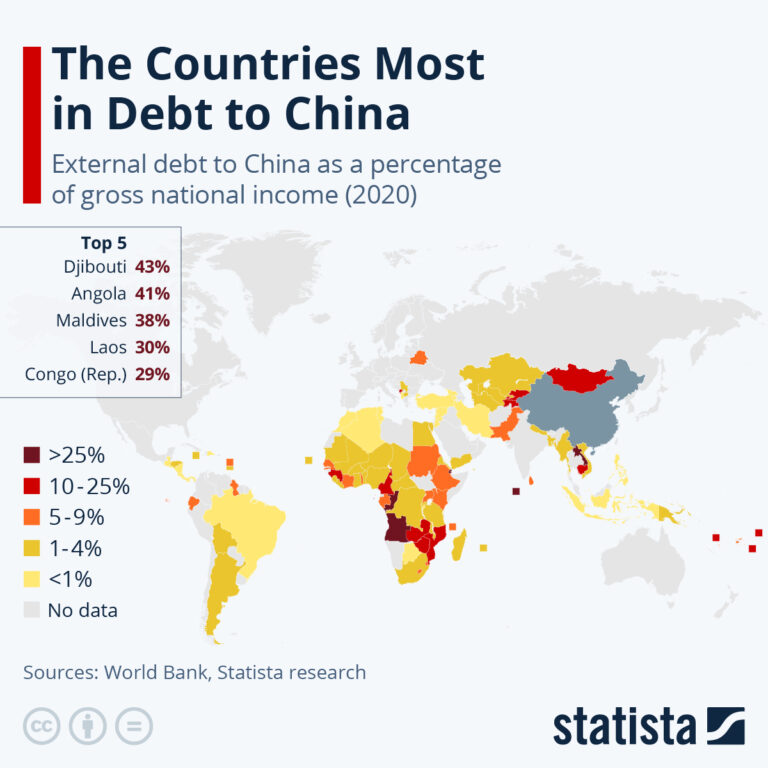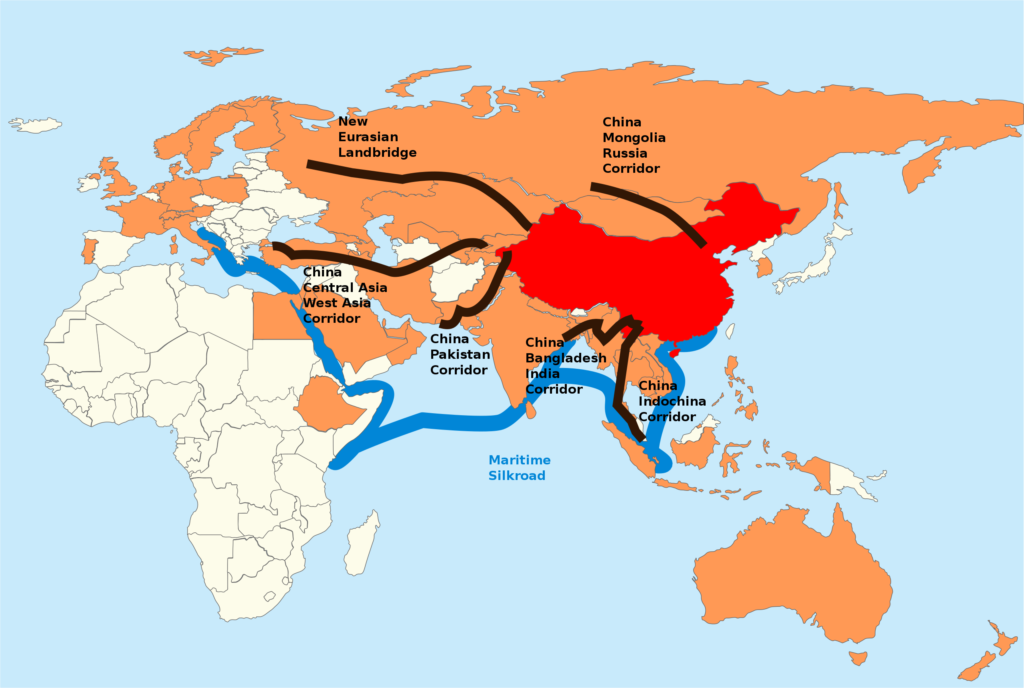Maps You Should Know is a series of articles which will provide you relevant information about a certain topic by using maps, graphs and charts.
This episode will be focused on the Belt and Road Initiative adopted by China and how it might become the modern version of the famous Silk Road.

Geographical Representation of External Debt to China (source: Statista)

The Belt and Road Initiative
Red - China; Orange - Members of the Asian Infrastructure Investment Bank
The What
The international strategy adopted by China after Xi Jingping took office in 2012 has been focused on spreading influence throughout the world and solidifying the Chinese role of leadership in the state of global affairs, a strategy which came to be known as Belt and Road Initiative (BRI) – or the New Silk Road. This strategy’s name derives from the web of routes, infrastructure and connections it intends to implement throughout Asia, Europe and Africa.
The Why
Its purpose lies in the reinforcement of international relations and partnerships in the 3 continents (by building trust between countries, leading to higher stability in the region – a great omen for economic prosperity), the growth and development of the economic markets (through easier flow of capital and improved land and water connections) and the enhanced integration and sustainable development of the countries throughout the route (namely by aiding the least developed ones), with China acting as the catalyst and the central element of this international strategy. Of course, with major investment and loaning in foreign countries, usually backed by collateral, the BRI also provides China with significant economic and political influence in these countries, a benefit which has not been acknowledged by the People’s Republic of China.
The How
China is implementing the BRI mainly through loaning, financing the construction of several different types of infrastructure in foreign countries, such as ports, skyscrapers, railroads, roads, bridges, airports, dams, coal-fired power stations and railroad tunnels. The money for such investments comes from different sources, such as the Asian Infrastructure Investment Bank (an asian development bank with an authorized capital of 100$ billion and China as its largest stakeholder) or the Silk Road Fund (a 40$ billion chinese state-owned development fund created to promote the BRI). Through means like these, China lends money, mostly to developing countries, and often with the security of collateral, for instance rights to the infrastructure being built.
The Where
Geographically, and as of August 2022, nearly 150 countries are signed up and taking part in the initiative. The routes span throughout Asia, Africa and Europe, through paths once traveled by the likes of Marco Polo or Ibn Battuta – as can be seen in the images above.
More specifically, in the first image we can see one of the causes for concern associated with the BRI – external debt. In countries like Djibouti, in 2020, the external debt to China accounted for 43% of the total Gross National Income. Moreover, Angola and the Maldives are in similar difficult situations, with possibly unsustainable amounts of debt to China. This scenario can lead to the default or re-negotiations of loans in these countries, increasing the Chinese foreign leverage and influence.
Pros vs. Cons
Of course the BRI has deeply divided opinions between those who see it as a legitimate strategy to improve international integration and development and those who see it as a deliberate attempt to increase influence and control abroad.
More specifically, the former usually focuses on the benefits that the BRI might provide, such as:
- Improvement of international markets (particularly in developing countries) through the construction of infrastructure which facilitates the movement of capital and goods, increases employment rates, stimulates industrialization and reduces economic inequalities;
- Improvement of international relations, through trust and confidence built by reciprocal economic aid, the bedrock for overall prosperity;
- Economic development, international integration and overall increased living standards in countries where loans take place, namely in landlocked countries (with reduced or no prior access to maritime routes).
While the latter centers their opinions on the drawbacks:
- Loans may focus on services and infrastructure that mostly benefit China in detriment of a stable development of the countries where they take place;
- Predatory loaning, known as debt-traps, with higher interest rates and shorter repayment windows than loans from international financial institutions, may put countries in difficult debt situations (as seen in the first image), leading to loan renegotiations or defaults and increasing Chinese leverage and bargaining potential, also jeopardizing the countries sovereignty over their territory (in cases like India or Pakistan) – something that can also be seen as a form of neo-colonialism or economic imperialism;
- Increase of chinese influence in the international scene deepens the east-west rivalry and may cause the west to retaliate, leading to a state of affairs resembling a modern version of the Cold War;
- Environmental and Human right risks are also major concerns – on the one hand, erosion, desertification, emission of pollutants, exhaustion of natural resources and ecosystem spoilage are real causes for concern brought by the BRI and, on the other hand, the multiple accusations China has suffered in the past regarding human rights violations and forced labor paint a dark picture which should be closely controlled.
And you – in which group do you see yourself? Do you prefer to focus on and give more importance to international development and improvement of relations and partnerships? Or are the possible drawbacks too many and too severe to be ovelooked?
Let us know down below!
by YKW // 15 October 2022
We'd love to hear from you
Contact Us
Got any suggestion, recommendation or idea that you would like to share with us? Feel free!